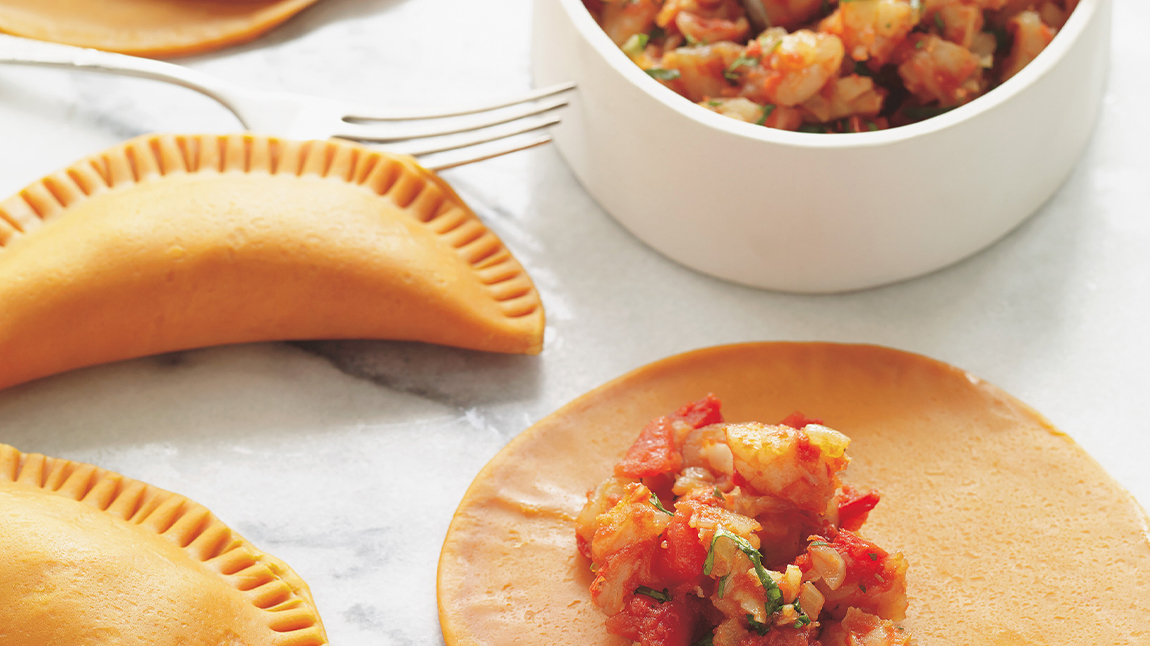Brazilian Pastéis de Camarão

Photo by Tina Rupp
From Sandra Gutierrez’s “Empanadas: The Hand-Held Pies of Latin America” (Stewart, Tabori & Chang, 2015). Gutierrez wrote: These empanadas are plump with shrimp—juicy and messy to eat. In Brazil, they’re called pastéis de camarão. The shrimp are coated with a sauce called molho or “wet sauce,” rich in tomato goodness. In Bahia, they’re served wrapped in paper to catch the juices. I make several batches ahead of time and freeze them, uncooked, so that I can fry them whenever the craving hits me. Paired with a green salad and a glass of wine, they make a delicious and easy supper in no time. If you don’t want to go through the trouble of making your own dough, use packaged annatto-flavored empanada discs for frying, or large egg roll wrappers. Shape them into half-moons or rolls (respectively), instead of making rectangles. If you’re lucky enough to find crawfish or langoustines, use them in place of shrimp.
Make the Dough: In a large bowl, whisk together the flour and salt. Make a well in the center. Add the lard or shortening and vinegar. Begin to mix the wet ingredients into the flour with a spoon as you add the water in a stream. When all the water has been added, switch to your hands and knead the dough until it comes together into a ball. Turn out the dough onto a lightly floured surface and knead until it is smooth, about 1 minute. Roll it out into a rectangle about 2 inches (5 cm) thick (this will make it easier to roll out fully) and wrap it in plastic; let it rest for 20 minutes.
Note: This dough cannot be frozen and is best used after resting for 20 minutes; once shaped, the empanadas can be frozen raw.
Note: you may also use ready-made dough. Try 12 store-bought annatto-flavored empanada discs or large egg roll wrapper.
Make the Filling: Heat the olive oil in a large skillet set over medium- high heat. Add the onions and sautée until they are golden, about 2 minutes. Add the tomatoes and tomato paste; sauté for 1 minute. Add 1⁄4 cup (60 ml) water and stir well to form a thick paste. Add the cilantro and salt; remove from the heat and let cool slightly. Add the shrimp or langoustines and stir well. Transfer the filling to a large bowl; cover and chill it for at least 30 minutes or up to overnight.
Assemble the Pastéis: While the filling chills, make the dough as directed on page 33 and let it rest, covered with plastic, for 20 minutes at room temperature. Line a large baking sheet with parchment paper; set it aside. Divide the dough in half. Roll out the first half to 1⁄16 inch (2 mm) thick (like for pasta). Using a pastry cutter or very sharp knife, cut it into 5-by-6-inch (12-by-15-cm) rectangles. Re-roll the scraps together, wrap them in the plastic, and allow them to rest for 20 minutes. In the meantime, repeat with the other half of the dough, cutting and re-rolling the scraps (while allowing the dough to rest in between) until you have 12 rectangles. You may have to do this a third time, until all are cut. The bottom side of the rectangles will be sticky; the top should be dry.
With a shorter side toward you and the sticky side facing up, place 2 tablespoons of the filling in the bottom half of each rectangle, leaving 1⁄2 inch (12 mm) all around. Fold the top over the filling and seal all of the sides well by pressing them together with your fingers. Crimp them tightly with the tines of a fork. Transfer them to the prepared baking sheet.
Fry the Pastéis and Serve: Fit a large baking sheet with a metal cooling rack; set it aside. In a large skillet with high sides, heat 1⁄2 to 1 inch (about 2 cm) of vegetable oil to 360°F (180°C) or use a deep-fryer according to the manu- facturer’s directions. Working in batches, carefully slide the pastéis into the oil. Fry them until they’re puffy and golden, 11⁄2 to 2 minutes, turning them over halfway through. If the oil gets too hot as you fry and they’re browning too quickly, lower the temperature and let the oil cool slightly before frying any more. Remove them with a slotted spoon and place them on the prepared rack to drain. Let them cool for 1 to 2 minutes and serve.
Note: Pastéis are best fried immediately after shaping and eaten immediately after they’re fried. Freeze them uncooked in a single layer; once solid, transfer them to freezer bags and keep them frozen for up to 3 months. Fry them without thawing (to prevent splatters) for 3 to 31⁄2 minutes, or until they are golden and crispy.